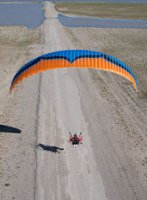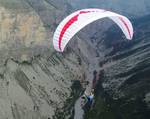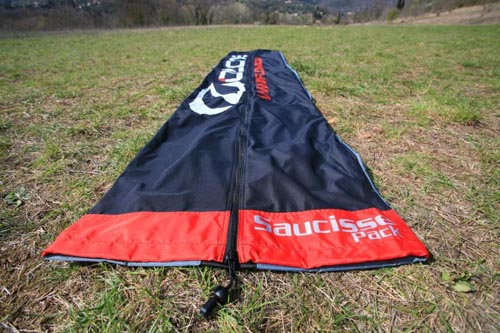REVIEW FROM SKYWINGS MAGAZINE MARCH 2013
Flight test (first Impressions) OZONE XXLITE Skywings March 2013
Chris Field got an XXLite for Christmas...
It all came together late last year, at least for this Lakeland pilot. After the miserabLe weather
of Last summer and autumn, winier was fast approachrng. The promise was of trudging
upwards through bog and snow, with prospects Littte better than a pleasant float back down to
the car. I love a long fly-down over the snow-covered fells on a crisp winter's day, Landing next
to a welcoming hostelry for a pint of Cumbria's finest in the warmth of an open fire in the
company of like-minded friends.
But that's not what happens. My experience
involves dragging yourself and kit, including the
extra paraphernalia of winter flying, as high as
endurance allows. The forecast Light wind turns
out to be an icy blast but, refusing to
contemplate the knee-crunching retreat to the
valley with your redundant Load, you sit it out.
Sweat freezes, muscles stiffen and morale sags.
The wind doesn't drop. inevitability, as dusk
approaches, you accept defeat and retreat, cold,
wet and despondent, to find the pub doesn't
open for another hour.
Yesterday, in near perfect winter conditions and with
a tight easterly forecast, I headed for the hills with
crampons and walking poles. I walked for a couple
of hours, saw no one, enjoyed the winter panoramas
and the exercise. Then, on reaching a convenient
launch, I laid out my XXLite on the pristine snow,
reverse launched in a nothing breeze and floated
down the few hundred metres to the valley. The pub
was open and the fire was blazing.
And that to me is the point of the XXLite - you
can have your cake and eat it! you can enjoy a
full day's walking [or climbing) in the mountains
combined with a flight, or even several flights.
And if you don't get to fly, it's no big deal. I have
been the enthusiastic owner of an XXLite since
25th December when, in a moment of exquisite
serendipity, my wife decided that it would make
the perfect Christmas present.
I have flown it half a dozen times, and carried it
on long walks without flying a couple more. This
report is not an earnest and balanced review by
an experienced and intrepid pilot; it is simply the
view of one rambler-pilot who is fed up wasting
great mountain days sitting on icy fell-sides
developing haemorrhoids. Conscious of my
paragliding limitations, I have drawn on the
views of other Lakes pilots who have flown the
glider with much more aplomb than me,
including Steve Giles of [ISick and the Wrong] and
Gordie Oliver [Air Ventures].
I should say at the start that I hadn't read any
of the many forum comments and reviews of
the XXLite before I bought it. The only exception
was the Ozone website information page,
whose '...a special wing for special pilots who
fully understand its Limitations, and have the
skill and experience to pilot it' comment gave
cause for caution. in fact Ozone are
reassuringly open about the limitations of the
glider and its special demands on the pilot. I
felt that as long as I maintained a cautious
approach, particularly with respect to strong
winds and turbulence ['...it should only be flown
in reasonably light wind and turbulence-free
conditions'), it would suit my purposes.
I don't need to repeat all the techie construction
information readily available through the normal
sources. My overriding impression on first
removing the glider from the sack was, 'Hmm,
l see... that's why it only weighs 1.2kg.'Even
though I had read the bumph it did seem as if
there was a lot missing. Like the bottom surface
l know, I know, but it still looked weird like
looking into its entrails and the missing risers
It only has A and B risers. The Dyneema [oops
connecting the lines are 'interesting', more so
when you are standing ready to launch. Most
interesting is the attachment of the Leading lines
(and unsheathed of course) to the top surface
which, in combination with the nylon inserts,
shapes the nose. Too late now, it's bought and
paid for.
Off to the hills. A small gaggle of CSC pilots
including Steve Giles, also armed with an XXLite,
headed up one of the higher fells for a classic
Lake District fly-down. We met up with a couple
more pilots carrying conventional heavyweight
kit for the walk up. Bliss! Carrying a 6kg sack in
the company of people carrying 20kg is the very
essence of schadenfreude. We arrived on the
summit to find the forecast Light wind was fresh
and 90 degrees off. No surprise there then.
Ozone's website warns that 'Launch behaviour in
stronger winds is more demanding as the wing
has a tendency to want to fly. It is best to control
the wall with the rear risers.' This is a bit of an
understatement, but at least those who'd Lugged
their heavy sacks up the hill could enjoy some
reverse-schadenfreude. Both Steve and l,
neither of whom had connected our gliders
before setting off, fought to control the frenzied
nylon which was behaving like delinquents on
tartrazine sandwiches.
This phenomenon is due to the extreme
lightness of the glider and the lack of around
5 kg air mass contained in conventional. gliders'
cells. By this reckoning the XXLite possesses
only about 10% of the mass and inertia of a
conventional 5kg glider. Having got connected
and calmed the canopy for long enough to get
clipped in and prepared for a reverse launch,
one fully experiences the 'tendency to want to
fly'; it was certainly more eager than me by
this stage.
To inflate the glider, Little if any pressure is
needed on the As; just lean back slightly whilst
being prepared to take a few steps forward as
the glider comes up, which will be fast. At that
point the fuss is over. The canopy now displays
the positive benefit it of its low inertia, with little
tendency to overshoot and just a delicate touch
required to control it. Once it is overhead it
becomes astonishingly stable and easy to
control, allowing for a re[axed and controlled
Launch. Subsequent nil-wind forward launches
have proved a doddle too.
l confess to a high degree of caution on this
first flight, largely induced by close reading of
the Ozone web pages and particular reference
to the Elite’s Light characteristics in
turbulence. Hence my flight plan was to get
well clear of the ridge before running down the
valley, bracing myself for a predictable [layer of
wind shear and potential turbulence as I flew
into the lee of the hill.. Nothing. Once in the air
it flew like any conventional low-performance
glider. it fluttered a little as I passed through
the wind shear, but apart from that it
behaved perfectly.
I flew with a little brake pressure, as
recommended by Ozone, but without
instruments and was unable to objectively
assess the glide or speed - having saved all
that weight it seemed a reckless waste to carry
a vario and four AA batteries. I was suspicious
of the glide angle, as I landed way short of my
objective but Steve, who had soared the ridge
before setting off down the valley, experienced
no such problem. Perhaps the weirdest thing
about flying a glider of such a radical design is
the normality. lt feels reassuringly stable and
responsive, easy to fly.
So comfortable did I find it I was suspicious that
I might be missing something, so I deferred to
Gordie Oliver. Having put the glider through its
paces with a more dynamic flight from Clough
Head, and then in stronger and strengthening
conditions from Souther Fell, he assessed the
feel as being, 'Subdued, very stable with very
Little pitch. lt feels like a beginner's glider, very
reassuring.'Gordie judged that the XXLite
showed little propensity to collapse, rather to
flutter and fold.
Unsurprisingly, given the glider’s slow speed,
Gordie experienced penetration problems on
Souther and described pushing forward as '...like
being on a motorway on a moped.'it is this sort
of situation where the limited exit strategy of the
XXLite becomes apparent. There is no speed
system, and although spirals and big ears are
feasible they are not as straightforward as on a
conventional glider. Given the construction of the
glider, perhaps less desirable too. Wing overs are
made more difficult by the tendency of the
canopy to centre itself,f. The consensus seems to
be that flying the XXLite is Like flying a
conventional EN A glider.
I found landing the XXLite disconcerting,
particularly as it was the aspect I hadn't really
focussed on when preparing to fly. I anticipated
the landing characteristics of a conventional
low-performance glider, and on making a fast
nil-wind approach I flared with the expectation of
a brief surge of lift followed by a gentle
touchdown. What I experienced was a more
rapid, high angle dumping into a Cumbrian bog.
The shin-deep bog prevented my attempt to run
off the speed but helped to absorb the impact
Half a dozen landings later I'm better prepared,
but a guaranteed smooth landing in light wind is
still a work in progress. My only landing into any
wind was pleasantly straightforward.
I have flown my 16m2 XXLite using both a Sup'Air
Altti rando reversible air bag harness and a KorteI
Kuik split-seat harness [I weigh 70kg in socks].
Both give a pack weight of around 6kg. Any
further weight reduction will involve sacrificing
back protection, which seems unnecessary when
I could easily Lose 3kg by spending more time
walking in the fells rather than sitting on my
backside waiting for the wind to drop. And
unwise given my landings!
The XXLite provides unexpected delights. As an
illustration of the ease of handling; with the
glider above my head I jogged and walked about
a kilometre from landing to my parked car
without dropping it. I’ve also discovered that it's
possible to pack the glider into its bag without
getting out of your harness. I am delighted to
have found a glider which so closely matches my
needs. Whilst I only intend to utilise a small part
of its potential, it's good to know that should the
opportunity arise I can top land on Mont Blanc -
or perhaps even Clough Head.
Importers Comment
Thank you to Chris for sharing his entertaining feedback. Whether
on your back or in the Air, we now know this wing makes many a pilot smile.
It started as a challenge about the feasability of a single surface paraglider.
The first attempt looked promising so we worked on it (for three years)
and decided it was not just a design challenge,but a wing that piklots might like to own.
Since its launch the interest has been great: we have been surprised how many pilots
were waiting for a wing like this. If you think this fits your bill, please speak to your nearest
dealer
Mike Cavannagh Ozone UK
- Shop
- Training
- Brands
- About Us
-
Welcome to our Store!
Axis paragliding is the registered Partnership of Stephen Millson and Catherine Betts. Axis was first registered in 1997, and was trading under another company name (trekking Uk Ltd) since 1992.

-
- Customer Service
-
Shipping
FREE UK SHIPPING OVER £100 VALUE We will attempt to ship your order within 4 days and will normally send your order to you in 2 business days. If you require your order urgently, please call to confirm, we will do our best to supply as quickly as possible.
Shop with Confidence
All goods remain the property of Axis Paragliding until paid for in full.
-
- Information
- Contact Us




